This HO 4-8-4 from Rivarossi is a welcome upgrade to an accurate and attractive model originally introduced in 1980. The new engine features RP-25 wheels, improved electrical pickup, flywheel drive, increased weight for traction, and wiring for plug-in installation of Digital Command Control (DCC).
The Rivarossi 4-8-4 was always a good model of its prototype, the Union Pacific FEF-3 class, and is now offered by exclusive importer Wm. K. Walthers with more-authentic paint and lettering, and with an oil tender. A magnetic knuckle coupler on the tender, working backup light, and darkened metal wheels and rods round out the new features.
The wheels are probably the greatest concern for modelers who remember when older Rivarossi locomotives had trouble operating on track manufactured to National Model Railroad Association standards, especially with rail sizes smaller than code 100. The new wheels on this 4-8-4 have the RP-25 contour that the NMRA specifies “for optimum track holding ability and most prototypical appearance within the interchange limits of NMRA standard S-4.”
While most of the engine and tender wheelsets are correctly gauged, I did find three pairs of drivers slightly narrow. The drivers can be removed from the frame and regauged with a wheel puller or similar device. Do not attempt to re-gauge the drivers by twisting them on their axles. Even if this were possible, it would wreck the “quartering” or 90-degree offset that allows the side rods to function correctly.
The main driver is equipped with a traction tire, which helps the engine achieve a remarkable drawbar pull. This tire didn’t cause any wobbling as the model ran, but Rivarossi has anticipated that some modelers will prefer not to have it. An optional main driver set without the traction tire is included.
The locomotive now picks up current from all eight drivers and from three wheels on each side of the tender. That’s still only 12 wheels out of an available total of 30, but quite a step up from the two pickup wheels on each side of the original models. Three wires from the cab plug into a small connector on the front of the tender for the pickup connections and to complete the circuit for the directional backup light.
The engine runs smoothly and quietly and has a realistic speed range. If anything, the prototype locomotives were capable of exceeding the model’s top speed. It actually starts moving at a lower voltage and speed than shown in the graph on page 156, which is its slowest sustained speed. The model can operate on much sharper curves, but will look its best on curves of 30″ radius or larger. On larger curves its adjustable drawbar may be shortened to bring the cab and tender closer together. The drawbar seemed tight on the tender pin and may be taking some weight off the front of the tender. I’d suspect this in any tender derailments and use a file to loosen the fit.
A decoder socket following NMRA recommendations is located under the combined steam and sand dome, which is removable. For actual decoder installation, however, it will be best to remove the boiler. This is a much easier task than on many recent steam models and is detailed in the manufacturer’s illustrated instruction sheet.
However, the instructions don’t mention that the boiler can’t be removed without disconnecting the three metal pipes from the feedwater heater atop the smokebox, and the metal reverse gear reach rod from the right front of the cab. The retainer holding the feedwater heater piping is easy to remove by pushing it out from inside the smokebox. Also, I found that front handrails would easily slide out of the stanchions on the air compressor shield as I lifted the boiler, so there’s no need to remove the stanchions per the instruction sheet.
If you’re considering a DCC sound installation, access to the tender is improved – the front and rear tender bulkheads are no longer glued and may easily be removed.
The red Mars signal light mounted above the headlight still doesn’t operate, but with the lighting functions available on many DCC decoders, that wouldn’t be difficult to fix. The smokebox front pulls out for access. However, the Union Pacific used these oscillating red lights as emergency stop signals, so they weren’t turned on in normal operation. The model shown is painted in the two-tone gray with yellow striping and lettering used on these locomotives from 1946 to 1949. (The roller-bearing journal covers on the trailing truck and tender were not painted silver before the late 1950s, but a little flat black paint will fix that.) The engine also has the smoke deflectors and signal light that were installed in 1947. It accurately represents the engines of that time except for three major details. The UP 4-8-4 tenders had a more rounded contour at the top that closely matched the curve of their cab roofs, but the model includes the same tender used with Rivarossi’s Challenger and Big Boy models. The trailing truck is also the same one used on the articulated engines; the 4-8-4 trucks had a contour that bumped up symmetrically over each journal box. And the model’s Worthington SA feedwater heater system represents equipment applied to some of these locomotives in the mid- 1950s. As built in 1944, the FEF-3s carried Elesco exhaust steam injectors on the fireman’s (left) side.
Many steam fans will probably overlook these discrepancies in an otherwise attractive and smooth- running engine, and of course the model is more accurate for late-’50s locomotives and fan-trip favorite no. 844. The model’s rods and valve gear are especially good-looking, and they’re set off by correctly scaled 80″ drivers.
Whether hauling a heavyweight limited or pinch-hitting on a Streamliner, Rivarossi’s upgraded FEF-3 will make a handsome sight.
Price:$239.98
Manufacturer:
Rivarossi, imported exclusively by Wm. K. Walthers Inc.
P.O. Box 3039
Milwaukee, WI 53201
414-527-0770
Description:
Plastic-and-metal ready-to-run Union Pacific steam locomotive
Features:
Blackened metal wheels, driver tires, and side rods
DCC decoder socket in locomotive
Directional headlights
Drawbar pull (with traction tire): 7.86 ounces
Eight-wheel drive with 12-wheelelectrical pickup
Engine and tender weight: 26 1/4 ounces (21 1/4 ounces for engine alone)
Flat can motor with flywheel
Magnetic knuckle coupler on tender only, height correct (dummy coupler on pilot gate)
Minimum radius: 18″
RP-25 contour wheelsets
Paint schemes (all UP):
Engine no. 843 in 1940s two-tone gray
Engine no. 844 in fan-trip black and dark graphite
Engine no. 840 in 1950s dual- service black and light graphite





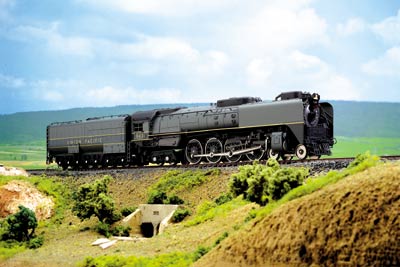
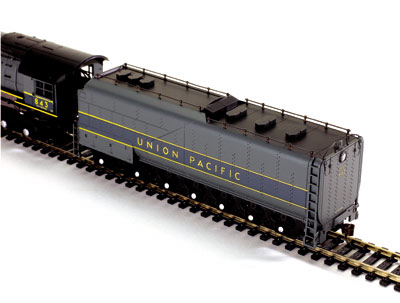
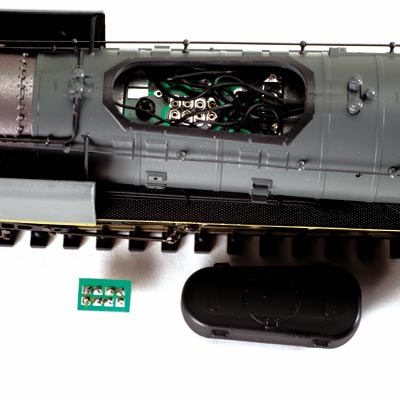
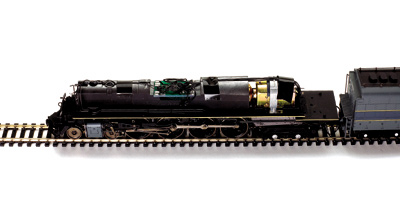
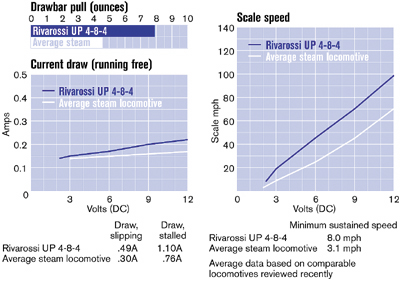









Rivarossi makes beautiful models. I have an old 0-8-0 yard engine from the late 1960's that still runs well today! The cast pot metal support frame on my Rivarossi Cab Forward is crumbling to dust though. The detail on these 60's models is very nice, even by today's standards. Rivarossi has come a long way since the 60's with far superior materials and electrictronics but there is some serious competition out there now, making choices more difficult. I will definitly say this is one nice looking model and worth taking a serious look at. I might not be able to leave the hobby shop without one! I give this model four stars due to ground breaking competition from other mfg's.
I own one of these wonderful steamers, and even after 30 top of the line engines, it's still my absolute favorite. You can't go wrong with one.
The engine should have an operating coupling on the pilot as well as the tender
Although it do not have a front coupler it is a fantastic steamer. It looks like the real thing